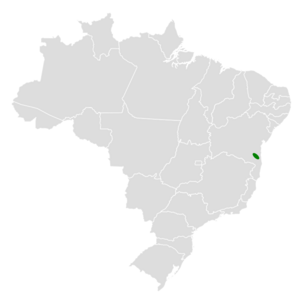Bahian mouse-colored tapaculo facts for kids
Quick facts for kids Bahian mouse-colored tapaculo |
|
|---|---|
| Conservation status | |
| Scientific classification | |
| Genus: |
Scytalopus
|
| Species: |
gonzagai
|
 |
|
The Bahian mouse-colored tapaculo is a small bird found only in Bahia, Brazil. It is also known as the Boa Nova tapaculo. This bird is a type of passerine bird, which means it belongs to a large group of birds often called "perching birds." Its scientific name is Scytalopus gonzagai.
Contents
Discovering the Bahian Tapaculo
Scientists first saw the Bahian mouse-colored tapaculo in the early 1990s. At first, they thought it was another type of tapaculo called the Scytalopus speluncae. This bird is also known as the mouse-colored tapaculo.
In 1999, another group of these birds was found nearby. This new group lived in a separate area. In 2014, scientists from the Universidade Federal de Pelotas in Brazil studied these birds closely. They realized that Scytalopus gonzagai was a completely new and different species.
Why is it called gonzagai?
The scientific name gonzagai was chosen to honor a Brazilian bird expert. His name was Luiz Antonio Pedreira Gonzaga. He discovered two other bird species in Bahia in the 1990s. Local people in Brazil call this bird the "Macuquinho-preto-baiano."
What Does it Look Like?
The Bahian mouse-colored tapaculo is covered in grey feathers. Its claws can be yellow or brown. This small bird is about 12 centimetres (4.7 in) long. It weighs around 15 grams (0.53 oz), which is very light.
Where Does it Live?
This bird lives only in a few special places in Brazil. Its home is in the Atlantic Forest in southern Bahia. It can be found in mountain areas. These areas are in the municipalities of Arataca, Boa Nova, and Iguaí.
The total area where they live is about 5,885 hectares. That's like a small forest! The Bahian tapaculo usually stays hidden. It likes to be under thick plants. It also stays on branches no higher than 2 metres (6.6 ft) off the ground.
How Does it Behave?
Male Bahian mouse-colored tapaculos like to have their own space. They are territorial, which means they protect their area. You might see a male bird alone or with a female bird. Females are usually only seen with a male.
These birds make three different kinds of calls. One call is a "kreew" sound. This sound might be how they talk to each other. They also have an alarm call to warn others of danger. Only the female birds sing a special song. On average, you might find about one bird for every two hectares of forest.
Is it in Danger?
The Bahian mouse-colored tapaculo is an endangered species. Scientists believe there are fewer than 2,883 of these birds left. Their homes are being destroyed. This happens because of logging (cutting down trees) and deforestation.
Because of these threats, scientists have asked for the bird to be listed as endangered. This means it needs special protection. This listing is done on the IUCN Red List, which tracks species in danger.


